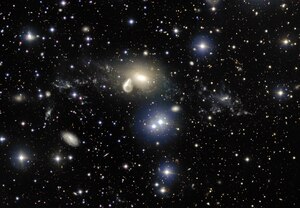NGC 5291
| Galaxy NGC 5291 |
|
|---|---|

|
|
| Image of the Very Large Telescope : above the center of the picture NGC 5291, immediately to the left of it «the Seashell» | |
| AladinLite | |
| Constellation | centaur |
|
Position equinox : J2000.0 , epoch : J2000.0 |
|
| Right ascension | 13 h 47 m 24.5 s |
| declination | -30 ° 24 ′ 25 ″ |
| Appearance | |
| Morphological type | E pec: poss. LINER |
| Brightness (visual) | 13.9 likes |
| Brightness (B-band) | 14.9 mag |
| Angular expansion | 1.2 ′ × 0.8 ′ |
| Position angle | 168 ° |
| Surface brightness | 13.9 mag / arcmin² |
| Physical data | |
| Affiliation | LGG 357 |
| Redshift | 0.014602 ± 0.000019 |
| Radial velocity | (4378 ± 6) km / s |
|
Stroke distance v rad / H 0 |
(190 ± 13) · 10 6 ly (58.2 ± 4.1) Mpc |
| history | |
| discovery | John Herschel |
| Discovery date | May 8, 1834 |
| Catalog names | |
| NGC 5291 • PGC 48893 • ESO 445-G030 • MCG -05-33-006 • 2MASX J13472445-3024250 • SGC 134433-3009.5 • GC 3646 • h 3535 • AM 1344-301 • HIPASS J1347-30 • LDCE 0996 NED051 | |
NGC 5291 is an elliptical galaxy about 190 million light-years away that interacts with a smaller, highly deformed galaxy nicknamed "the Seashell" . NGC 5291 lies on the western outskirts of Abell 3574 and is possibly a member of this galaxy cluster.
The galaxy was first identified by Longmore et al. examined in more detail in a study published in 1979. The nickname “the Seashell” for the interacting galaxy, which seems to fly past NGC 5291 at a large speed difference, goes back to them.
NGC 5291 was discovered by the British astronomer John Herschel on May 8, 1834 .
Web links
Commons : NGC 5291 - collection of images, videos, and audio files
- ESO: VLT faces another strange cosmic collision December 9, 2015
